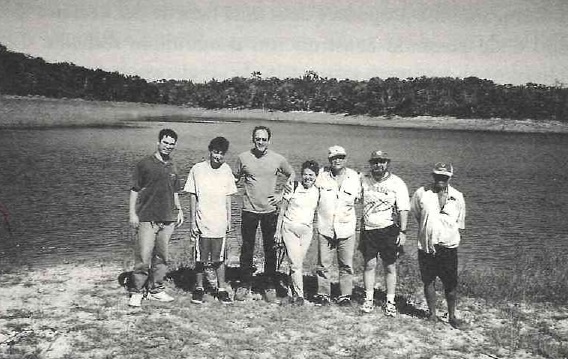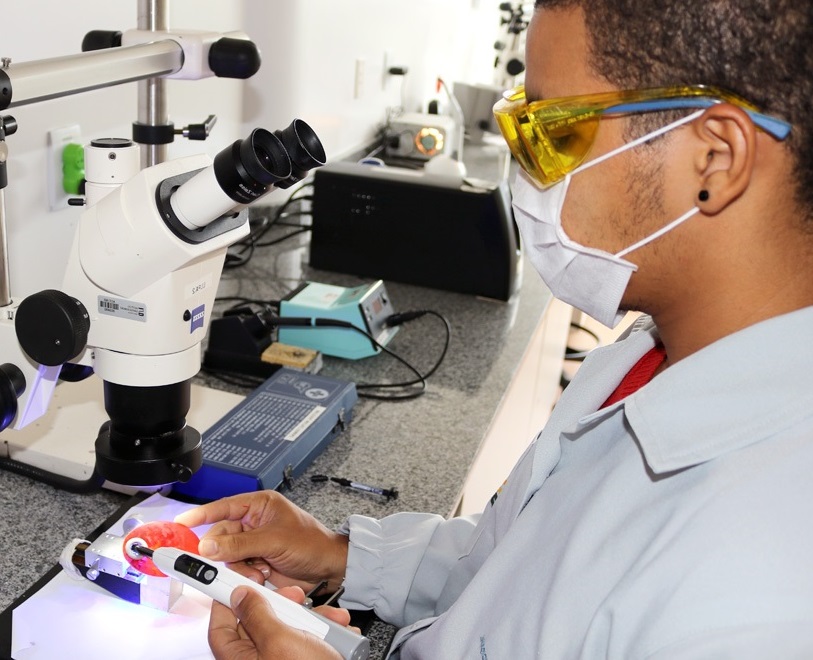
Renata Moura and Kamila Tuenia
reporters
“In front of a municipality with thousands of people, a state with thousands of people, a country, a world populated by billions, who are you? What are you going to be?
The question was asked to children lying down in a classroom, led to reflect on the place they would occupy in the world.
The year was 2007 and among them was José Firmino Neto, who 13 years later would become the first Master in Neuroengineering born in Macaíba, municipality ofRio Grande do Norte, with 81,821 inhabitants and a low Municipal Human Development Index (HDI) in education, according to the most recent data from the United Nations Development Program (UNDP).
The master's diploma was delivered at the end of September this year by the International Institute of Neurosciences Edmond and Lily Safra (IIN-ELS), of the Santos Dumont Institute (ISD), a social organization of the federal government that is linked to the Ministry of Education and has headquarters in the municipality.
It was not, however, in the chairs of the graduate program – the first in Brazil in this area of knowledge – that the story involving the boy and the Institute began.
The school
Between the four walls of the classroom where dozens of children thought about “what they were going to be” when they grew up, Firmino was one of the elementary school students who took part in the first class of Science Education workshops at the Alfredo J. Monteverde Science Education Center, that ISD maintained until 2017 in Macaíba.
The CECs, as the Centers were called, used practical classes in laboratories to introduce the most important concepts of science to children between 10 and 15 years old. More than 7,000 students from 102 public schools in Rio Grande do Norte and Bahia were benefited.
At the opposite time to the schools where they studied, boys and girls participated in the Centers of science and technology, physics, chemistry, robotics, biology, environment, history, art and communication workshops.
It was at Alfredo J. Monteverde that Firmino's taste for science began, on a path that, he hopes, is far from coming to an end.
“My entire career at the Institute has meant a lot to my life and my future. Now, my plans are to finish my doctorate (in Neurosciences, at the Federal University of Rio Grande do Norte – UFRN) and continue carrying out large projects. I want to do my postdoctoral work abroad to be a research professor in neurosciences in the future. The opportunities out there can be better and I want to embrace them not to leave here. But to go back and build more opportunities for children and young people like me, and to give back for everything I learned at the Institute”.
Education
The son of self-employed workers who always did their best to ensure his education, Firmino initially studied in public schools in the city and later in private schools whose tuition his parents paid, in part, by selling snacks.
“Opportunity and luck” are the first words that come to his mind about the story he stars in.
“I feel lucky and I would even say privileged to have a family that fought so hard for me to have a quality education”, he says. “Having the opportunity was also essential. I had the opportunity to be introduced to knowledge and I was able to jump at every chance to learn. Back in childhood, that reflection on what our existence represented taught me that I could build whatever I wanted with knowledge and I still have that with me today”, he says, sitting in a room at the IIN-ELS where he grants the interview holding, with two hands, one brain replica used in class.
History
A black and white photo records an old episode involving the now doctoral student and the International Institute of Neurosciences Edmond and Lily Safra.
José Firmino Rodrigues, his grandfather, was the one who presented the land that would host the IIN-ELS to the neuroscientist and founder of the Institute, Miguel Nicolelis, in 2003.
The image shows the first visit to the area, years later named “Brain Campus”.
“My grandfather was a retired UFRN employee, he took care of the land at the Agricultural School of Jundiaí, in the rural area of Macaíba. He drove a tractor School and he was the one who took Nicolelis and the scientists to get to know the terrain. Arriving there and hearing the stories that there was going to be an education and science center that could transform realities, he was enchanted”, says Firmino.
Unknowingly, the man posing to the left of Nicolelis, with a group of neuroscientists in the photo, years later would have the grandson as part of the story.

“Miguel Nicolelis talks in one of his books about utopia, which is to produce education and knowledge where there is no possibility. Macaíba is a city with a deficit huge in education and here we often think that we need to go abroad or to the capital to study. ISD deconstructed this in my life. Having an opportunity like this in the city where I was born, raised and live today was a dream I hope I never wake up from”, adds the Macaib native.
Scientific research
After completing high school, Firmino passed the entrance exams for courses in Literature, Accounting, Logic Programming and Psychology. It was in the latter that he decided to stay and where he is now a graduate of the Potiguar University (UnP).
The reunion with the ISD took place when I was still an undergraduate and I knew exactly what I wanted: to embark on the research area.
“The funniest thing was that when I entered the ISD Scientific Initiation, I didn’t know, I had no idea that there had once been my home, the place that sharpened my creativity”, he says with a smile, for not having associated at first glance the Institution to the school where, as a child, I studied science. “When I discovered (this relationship), the motivation to do my best became even greater”.
Research

Firmino entered his master's degree in 2018 and defended his dissertation in 2020, aged 26. In the work, entitled “Development of a behavioral task for studies of discrimination of auditory stimuli and decision making in marmosets (Callithrix jacchus)”, developed a behavioral training protocol for marmosets to discriminate auditory stimuli. He was guided by researcher Mariana Ferreira Araújo, professor at IIN-ELS/ISD until May 2019.
“The neurobiology of marmosets can be compared to characteristics found in humans due to their evolutionary proximity and similarity of the auditory system. The result of this work can generate contributions regarding the evolution of our vocal communication and in different cognitive aspects”, he summarized for the ISD 2020.1 report, which presents the results achieved by the Institute in the first half of the year for monitoring by the Ministry of Education.
At the end of 2019, 38 students were regularly enrolled in the IIN-ELS Master in Neuroengineering, coming from courses such as biomedical engineering, computer engineering, medicine, biological sciences, electrical engineering, computer science, nursing, biotechnology, civil engineering, engineering control and automation, chemical engineering, physiotherapy, psychology, biomedicine and speech therapy.
The master's program began in August 2013 and since then, until June 2020, 104 students have joined and 59 have defended their dissertation. They are students from different states, from North to South of Brazil.

“Path to the future”
“This institution made me develop all the skills that in a real world I would never have imagined possible. I watched many other young people like me lose their lives to crime, to drugs, and I could be one of them, but education was my path to the future. My father, Seu Gilvan, waking up at dawn to sell snacks so I can study is my greatest example. Thanks to his efforts, that of my mother (Maria Salete) and my grandparents to ensure that I could have a quality education, even if it cost more than we could afford, that I am here”, reports the researcher and reinforces: “I I grew up at the Institute, here I learned that without education we are nothing and that we needed to take advantage of knowledge to succeed in life”.
For the general director of the Santos Dumont Institute, Reginaldo Freitas Júnior, “Firmino is the personification of the mission of building education for life, providing opportunities and guaranteeing growth for the city and its actors”.
“It truly embodies our dream of lifelong education. If we think, for example, of the sustainable development goals, one of which is to guarantee quality education and learning at all stages of life, seeing that this is a story of the results that this right can bring, makes us believe in the power transformation of education that values, recognizes and builds so many things”.
The dream of transforming education also involves territorial, economic and social development, according to Freitas Júnior. “Our goal is also to give people the opportunity not only to grow professionally, but personally and economically. Being here, inside a metropolitan city to create an ecosystem of socioeconomic development through education, science, research. Firmino proves that this is possible and will continue to be, as we want a lot more Firminos and Firminas in here”, observes the director.

Stories that intersect
Firmino is the first Master in Neuroengineering to be born in Macaíba, but other young researchers with roots in the municipality are also part of the history of the Graduate Program.
The first to receive the diploma was physiotherapist Ozair Argentille, who was born in the capital, Natal, but lived in the municipality. In the dissertation he defended in February 2019, his focus was on children with microcephaly.
“It's something like that, practically a dream. And I hope that I, Ozair and Firmino will be the pioneers for so many other people from Macaíba to come”, says the biomedical Maria Heloísa Vasconcelos, 23, who was born in neighboring São Gonçalo do Amarante, “because the maternity hospital in Macaíba was closed”, but whose home is in the municipality and where, in 2021, she should also train as a neuroengineer.
“I have neighbors who work at the Institute, who have already helped with the construction and even for them it is a source of pride to have someone from the neighborhood, someone they know, who is studying here”, she says with emotion.

Heloísa studies the reconsolidation of memories based on the so-called direct current transcranial stimulation technique, which explains its clinical use in physiotherapy in the treatment of people with Parkinson's disease. “We still don't know how to explain some of the mechanisms that make this technique successful. Therefore, what I investigate is the molecular part and effectiveness of the method in promoting cognitive and memory improvements”. The work is supervised by the IIN-ELS/ISD researcher, Maria Carolina Gonzalez.
The biomedical scientist saw the International Institute of Neurosciences, of the ISD, as a distant possibility for her own path.
“I didn't even know what the Institute was, I thought it wasn't for me”.
Until I heard about the Graduate Program in Neuroengineering and found out that the opportunity and its space were also there. “I found out about the Institute, I unpretentiously sent an email to Edgard (Morya, IIN-ELS research coordinator) and he said 'come' and I came to meet. Who introduced me to everything was Firmino. When I saw an institution like this, with so many instruments, technologies and techniques that people use abroad, I thought 'I'm going to stay right here'”.
Heloísa is moved when remembering her trajectory as a student, university student and now a researcher. “Getting this far was something I thought was unattainable for me, that's the truth. I am already a differential in my city for having graduated from a public school. This is rare. And it's even rarer for me to get to graduate school in Macaíba”.
According to United Nations Development Program (UNDP), on a scale of 0 to 1, in which the closer to 1 the greater the Municipal Human Development Index (MHDI), Macaíba appears with 0.545 in relation to education, a position classified as low development and which is on step 2,458 in the ranking of Brazil – amid a total of 5,565 municipalities. The number is 34% lower than that achieved in Águas de São Pedro (SP), the Brazilian municipality with the highest IDHM Education (0.825), and 21.46% lower than that registered in Natal, capital of Rio Grande do Norte, with an index of 0.694, in 436th ranking position.
In the book Made in Macaíba (2016), in which he explains the origins of the Campus do Cérebro and the International Institute of Neurosciences Edmond and Lily Safra, the neuroscientist Miguel Nicolelis already highlighted the low levels of human development in Macaíba and observed one of the results he saw with the project he implemented in the municipality.
“Our students learned early on that they were indeed capable of anything (…) someone not only said they had complete confidence in their ability to conquer their own future, but also categorically stated that that future could be anything they wanted it to be.” , even if it involved the very definition of the impossible”.
Text: Renata Moura – Journalist / Ascom – ISD and Kamila Tuenia – Journalism Intern / Ascom ISD
Communication Office
comunicacao@isd.org.br
(84) 99416-1880
Santos Dumont Institute (ISD)
It is a Social Organization linked to the Ministry of Education (MEC) and includes the Edmond and Lily Safra International Institute of Neurosciences and the Anita Garibaldi Health Education and Research Center, both in Macaíba. ISD's mission is to promote education for life, forming citizens through integrated teaching, research and extension actions, in addition to contributing to a fairer and more humane transformation of Brazilian social reality.


















